Improving Atmospheric Temperature and Relative Humidity Profiles Retrieval Based on Ground-Based Multichannel Microwave Radiometer and Millimeter-Wave Cloud Radar
Abstract
:1. Introduction
2. Materials and Method
2.1. Materials
2.1.1. Measurement Principle
2.1.2. Forward Problem and Inverse Problem
2.2. Data Sources
2.3. Pre-Treatment of the Experimental Data
2.4. Evaluation Metrics
2.5. MonoRTM Reliability Validation
2.5.1. MonoRTM
2.5.2. Brightness Temperature Correction
2.6. Experimental Methods and Analysis
2.6.1. Retrieval Method
2.6.2. Sample Construction
2.6.3. Sensitivity Experiments of Cloud Information
3. Results
4. Conclusions
- (1)
- The MonoRTM simulated brightness temperature had significantly higher errors under cloudy conditions than clear conditions. This phenomenon was more significant in the water vapor channel and the first five channels of the retrieval temperature, and it can be speculated that these channels may be more sensitive to the water vapor content of the cloud information compared to the other channels.
- (2)
- The effect of different cloud-base heights and cloud thicknesses on the temperature profiles was not significant. However, for the relative humidity profiles, altering the cloud-base height and thickness led to significant changes in the relative humidity and its peak. Altering the thickness led to a significant increase in the relative humidity within the cloud layer. For low cloud conditions, when changing the cloud-base height or cloud thickness, 2 km is the critical height layer for significant differences in RH profiles; for high cloud conditions, the critical height layer is 4 km.
- (3)
- For temperature profile retrieval under clear conditions, both the BPNN and GMR retrievals demonstrated better performance. Overall, the errors of the temperature profiles increased with an increase in altitude, and the error of GMR retrieval was slightly higher than that of BPNN retrieval. However, for RH profile retrieval, the BPNN retrieval of the RH profiles was significantly better than GMR retrieval. This is related to the fact that some channels of the microwave radiometer are more sensitive to water vapor information.
- (4)
- For temperature and RH profile retrieval under cloudy conditions, it can be seen from the typical cases that the temperature profile retrieval was basically stable; in the height ranges of single-layer and double-layer clouds, the sounding relative humidity increased sharply due to the influence of water vapor in the clouds. The comparison experiments revealed that cloud thickness was the main factor affecting the relative humidity profiles. For thick clouds, the GMR and BPNN retrieval method without cloud information demonstrated the largest errors. With the cloud information, the accuracy of the BPNN retrieval was improved above 2 km, especially in thick clouds. The retrieval temperature and relative humidity profiles with the cloud information were better than the retrieval without the cloud information. The retrieval temperature and RH profiles with the cloud information were closer to the sounding data compared with the retrieval without the cloud information. From a quantitative point of view, the errors of the retrieval of temperature and relative humidity profiles slightly improved with the addition of cloud information.
Author Contributions
Funding
Institutional Review Board Statement
Informed Consent Statement
Data Availability Statement
Conflicts of Interest
References
- Li, H.; Cheng, J.; Zhang, Q.; Zheng, B.; Zhang, Y.; Zheng, G.; He, K. Rapid Transition in Winter Aerosol Composition in Beijing from 2014 to 2017: Response to Clean Air Actions. Atmos. Chem. Phys. 2019, 19, 11485–11499. [Google Scholar] [CrossRef]
- Temimi, M. On the Analysis of Ground-Based Microwave Radiometer Data during Fog Conditions. Atmos. Res. 2020, 231, 104652. [Google Scholar] [CrossRef]
- Yan, X.; Liang, C.; Jiang, Y.; Luo, N.; Zang, Z.; Li, Z. A Deep Learning Approach to Improve the Retrieval of Temperature and Humidity Profiles from a Ground-Based Microwave Radiometer. IEEE Trans. Geosci. Remote Sens. 2020, 58, 8427–8437. [Google Scholar] [CrossRef]
- Hu, J.; Bao, Y.; Liu, J.; Liu, H.; Petropoulos, G.P.; Katsafados, P.; Zhu, L.; Cai, X. Temperature and Relative Humidity Profile Retrieval from Fengyun-3D/HIRAS in the Arctic Region. Remote Sens. 2021, 13, 1884. [Google Scholar] [CrossRef]
- Zhou, Z.; Kou, X.; Zhao, S.; Jiang, L. A New Method to Inverse Soil Moisture Based on Thermal Infrared and Passive Microwave Remote Sensing. In Land Surface Remote Sensing II; Jackson, T.J., Chen, J.M., Gong, P., Liang, S., Eds.; SPIE: Beijing, China, 2014; p. 926026. [Google Scholar]
- Laroche, S.; Sarrazin, R. Impact of Radiosonde Balloon Drift on Numerical Weather Prediction and Verification. Weather Forecast. 2013, 28, 772–782. [Google Scholar] [CrossRef]
- Seidel, D.J.; Sun, B.; Pettey, M.; Reale, A. Global Radiosonde Balloon Drift Statistics. J. Geophys. Res. 2011, 116, D07102. [Google Scholar] [CrossRef]
- Seidel, D.J.; Randel, W.J. Variability and Trends in the Global Tropopause Estimated from Radiosonde Data. J. Geophys. Res. 2006, 111, 2006JD007363. [Google Scholar] [CrossRef]
- Seidel, D.J.; Ao, C.O.; Li, K. Estimating Climatological Planetary Boundary Layer Heights from Radiosonde Observations: Comparison of Methods and Uncertainty Analysis. J. Geophys. Res. 2010, 115, D16113. [Google Scholar] [CrossRef]
- Qi, Y.; Fan, S.; Li, B.; Mao, J.; Lin, D. Assimilation of Ground-Based Microwave Radiometer on Heavy Rainfall Forecast in Beijing. Atmosphere 2022, 13, 74. [Google Scholar] [CrossRef]
- Cao, Y.; Shi, B.; Zhao, X.; Yang, T.; Min, J. Direct Assimilation of Ground-Based Microwave Radiometer Clear-Sky Radiance Data and Its Impact on the Forecast of Heavy Rainfall. Remote Sens. 2023, 15, 4314. [Google Scholar] [CrossRef]
- Shi, J.; Du, Y.; Du, J.; Jiang, L.; Chai, L.; Mao, K.; Xu, P.; Ni, W.; Xiong, C.; Liu, Q.; et al. Progresses on Microwave Remote Sensing of Land Surface Parameters. Sci. China Earth Sci. 2012, 55, 1052–1078. [Google Scholar] [CrossRef]
- Payne, V.H.; Mlawer, E.J.; Cady-Pereira, K.E.; Moncet, J.-L. Water Vapor Continuum Absorption in the Microwave. IEEE Trans. Geosci. Remote Sens. 2011, 49, 2194–2208. [Google Scholar] [CrossRef]
- Loehnert, U.; Maier, O. Operational Profiling of Temperature Using Ground-Based Microwave Radiometry at Payerne: Prospects and Challenges. Atmos. Meas. Tech. 2012, 5, 1121–1134. [Google Scholar] [CrossRef]
- Candlish, L.M.; Raddatz, R.L.; Asplin, M.G.; Barber, D.G. Atmospheric Temperature and Absolute Humidity Profiles over the Beaufort Sea and Amundsen Gulf from a Microwave Radiometer. J. Atmos. Ocean. Technol. 2012, 29, 1182–1201. [Google Scholar] [CrossRef]
- Sánchez, J.L.; Posada, R.; García-Ortega, E.; López, L.; Marcos, J.L. A Method to Improve the Accuracy of Continuous Measuring of Vertical Profiles of Temperature and Water Vapor Density by Means of a Ground-Based Microwave Radiometer. Atmos. Res. 2013, 122, 43–54. [Google Scholar] [CrossRef]
- Ware, R.; Cimini, D.; Campos, E.; Giuliani, G.; Albers, S.; Nelson, M.; Koch, S.E.; Joe, P.; Cober, S. Thermodynamic and Liquid Profiling during the 2010 Winter Olympics. Atmos. Res. 2013, 132–133, 278–290. [Google Scholar] [CrossRef]
- Wei, J.; Shi, Y.; Ren, Y.; Li, Q.; Qiao, Z.; Cao, J.; Ayantobo, O.O.; Yin, J.; Wang, G. Application of Ground-Based Microwave Radiometer in Retrieving Meteorological Characteristics of Tibet Plateau. Remote Sens. 2021, 13, 2527. [Google Scholar] [CrossRef]
- Askne, J.; Westwater, E. A Review of Ground-Based Remote Sensing of Temperature and Moisture by Passive Microwave Radiometers. IEEE Trans. Geosci. Remote Sens. 1986, GE-24, 340–352. [Google Scholar] [CrossRef]
- Cimini, D.; Hewison, T.J.; Martin, L.; Güldner, J.; Marzano, F.S. Temperature and Humidity Profile Retrievals from Ground-Based Microwave Radiometers during TUC. Meteorol. Z. 2006, 15, 45–56. [Google Scholar] [CrossRef]
- Bianco, L.; Cimini, D.; Marzano, F.S.; Ware, R. Combining Microwave Radiometer and Wind Profiler Radar Measurements for High-Resolution Atmospheric Humidity Profiling. J. Atmos. Ocean. Technol. 2005, 22, 949–965. [Google Scholar] [CrossRef]
- Klaus, V.; Bianco, L.; Gaffard, C.; Matabuena, M.; Hewison, T.J. Combining UHF Radar Wind Profiler and Microwave Radiometer for the Estimation of Atmospheric Humidity Profiles. Meteorol. Z. 2006, 15, 87–97. [Google Scholar] [CrossRef]
- Liljegren, J.C.; Clothiaux, E.E.; Mace, G.G.; Kato, S.; Dong, X. A New Retrieval for Cloud Liquid Water Path Using a Ground-Based Microwave Radiometer and Measurements of Cloud Temperature. J. Geophys. Res. 2001, 106, 14485–14500. [Google Scholar] [CrossRef]
- Chan, P.W. Performance and Application of a Multi-Wavelength, Ground-Based Microwave Radiometer in Intense Convective Weather. Meteorol. Z. 2009, 18, 253–265. [Google Scholar] [CrossRef]
- Ren, Y.J. Inversion of Temperature and Humidity Profile of Microwave Radiometer Based on BP Network. Intell. Autom. Soft Comput. 2021, 29, 741–755. [Google Scholar]
- Frate, F.D.; Schiavon, G. A Combined Natural Orthogonal Functions/Neural Network Technique for the Radiometric Estimation of Atmospheric Profiles. Radio Sci. 1998, 33, 405–410. [Google Scholar] [CrossRef]
- Solheim, F.; Godwin, J.R.; Westwater, E.R.; Han, Y.; Keihm, S.J.; Marsh, K.; Ware, R. Radiometric Profiling of Temperature, Water Vapor and Cloud Liquid Water Using Various Inversion Methods. Radio Sci. 1998, 33, 393–404. [Google Scholar] [CrossRef]
- Li, Q.; Wei, M.; Wang, Z.; Jiang, S.; Chu, Y. Improving the Retrieval of Cloudy Atmospheric Profiles from Brightness Temperatures Observed with a Ground-Based Microwave Radiometer. Atmosphere 2021, 12, 648. [Google Scholar] [CrossRef]
- Turner, D.D.; Clough, S.A.; Liljegren, J.C.; Clothiaux, E.E.; Cady-Pereira, K.E.; Gaustad, K.L. Retrieving Liquid Wat0er Path and Precipitable Water Vapor From the Atmospheric Radiation Measurement (ARM) Microwave Radiometers. IEEE Trans. Geosci. Remote Sens. 2007, 45, 3680–3690. [Google Scholar] [CrossRef]
- Clough, S.A.; Shephard, M.W.; Mlawer, E.J.; Delamere, J.S.; Iacono, M.J.; Cady-Pereira, K.; Boukabara, S.; Brown, P.D. Atmospheric Radiative Transfer Modeling: A Summary of the AER Codes. J. Quant. Spectrosc. Radiat. Transf. 2005, 91, 233–244. [Google Scholar] [CrossRef]
- Fixsen, D.J. The Temperature of the Cosmic Microwave Background. Astrophys. J. 2009, 707, 916–920. [Google Scholar] [CrossRef]
- Zhao, B.; Fu, Q.; Du, J.; Hu, C.; Li, H. Microwave Remote-Sensing of Atmospheric Property and Weather Process. Sci. China Ser. B-Chem. Life Sci. Earth Sci. 1991, 34, 352–362. [Google Scholar]
- Pan, Y. Analysis on the Solar Influence to Brightness Temperatures Observed with a Ground-Based Microwave Radiometer. J. Atmos. Sol.-Terr. Phys. 2021, 222, 105725. [Google Scholar] [CrossRef]
- Che, Y.; Ma, S.; Xing, F.; Li, S.; Dai, Y. An Improvement of the Retrieval of Temperature and Relative Humidity Profiles from a Combination of Active and Passive Remote Sensing. Meteorol. Atmos. Phys. 2019, 131, 681–695. [Google Scholar] [CrossRef]
- Cimini, D.; Marzano, F.S.; Ciotti, P.; Westwater, E.R.; Kehim, S.J.; Han, Y. Empirical Evaluation of Four Microwave Radiative Forward Models Based on Ground-Based Radiometer Data near 20 and 30 GHz. In Proceedings of the IGARSS 2003: IEEE International Geoscience and Remote Sensing Symposium, Vols I—VII, Proceedings: Learning from Earth’s Shapes and Sizes, Toulouse, France,, 21–25 July 2003; IEEE: New York, NY, USA, 2003; pp. 1502–1504. [Google Scholar]
- Tan, H.; Mao, J.; Chen, H.; Chan, P.W.; Wu, D.; Li, F.; Deng, T. A Study of a Retrieval Method for Temperature and Humidity Profiles from Microwave Radiometer Observations Based on Principal Component Analysis and Stepwise Regression. J. Atmos. Ocean. Technol. 2011, 28, 378–389. [Google Scholar] [CrossRef]
- Hu, H.-Y.; Lee, Y.-C.; Yen, T.-M.; Tsai, C.-H. Using BPNN and DEMATEL to Modify Importance–Performance Analysis Model—A Study of the Computer Industry. Expert Syst. Appl. 2009, 36, 9969–9979. [Google Scholar] [CrossRef]
- Ghose, D.K.; Panda, S.S.; Swain, P.C. Prediction of Water Table Depth in Western Region, Orissa Using BPNN and RBFN Neural Networks. J. Hydrol. 2010, 394, 296–304. [Google Scholar] [CrossRef]
- Bashir, T.; Haoyong, C.; Tahir, M.F.; Liqiang, Z. Short Term Electricity Load Forecasting Using Hybrid Prophet-LSTM Model Optimized by BPNN. Energy Rep. 2022, 8, 1678–1686. [Google Scholar] [CrossRef]
- Rumelhart, D.E.; Hinton, G.E.; Williams, R.J. Learning Representations by Back-Propagating Errors. Nature 1986, 323, 533–536. [Google Scholar] [CrossRef]
- Dai, H.; MacBeth, C. Effects of Learning Parameters on Learning Procedure and Performance of a BPNN. Neural Netw. 1997, 10, 1505–1521. [Google Scholar] [CrossRef]
- Yu, W.; Xu, X.; Jin, S.; Ma, Y.; Liu, B.; Gong, W. BP Neural Network Retrieval for Remote Sensing Atmospheric Profile of Ground-Based Microwave Radiometer. IEEE Geosci. Remote Sens. Lett. 2022, 19, 4502105. [Google Scholar] [CrossRef]
- Xi, C.; Qi-feng, L.; Quan, Z. 0–10 km Temperature and Humidity Profiles Retrieval from Ground-Based Microwave Radiometer. J. Trop. Meteorol. 2018, 24, 243–252. [Google Scholar]
- Wanas, N.; Auda, G.; Kamel, M.S.; Karray, F. On the Optimal Number of Hidden Nodes in a Neural Network. In Proceedings of the Conference Proceedings. IEEE Canadian Conference on Electrical and Computer Engineering (Cat. No.98TH8341), Kingston, ON, Canada, 25–28 May 1998; Volume 2, pp. 918–921. [Google Scholar]
- Cai, G.-W.; Fang, Z.; Chen, Y.-F. Estimating the Number of Hidden Nodes of the Single-Hidden-Layer Feedforward Neural Networks. In Proceedings of the 2019 15th International Conference on Computational Intelligence and Security (CIS), Macao, China, 13–16 December 2019; pp. 172–176. [Google Scholar]
- Li, Y.; Yan, J.; Sui, X. Tropospheric Temperature Inversion over Central China. Atmos. Res. 2012, 116, 105–115. [Google Scholar] [CrossRef]
- Zhou, X.; Zhang, C.; Li, Y.; Sun, J.; Chen, Z.; Li, L. Concurrence of Temperature and Humidity Inversions in Winter in Qingdao, China. Geophys. Res. Lett. 2024, 51, e2024GL108350. [Google Scholar] [CrossRef]
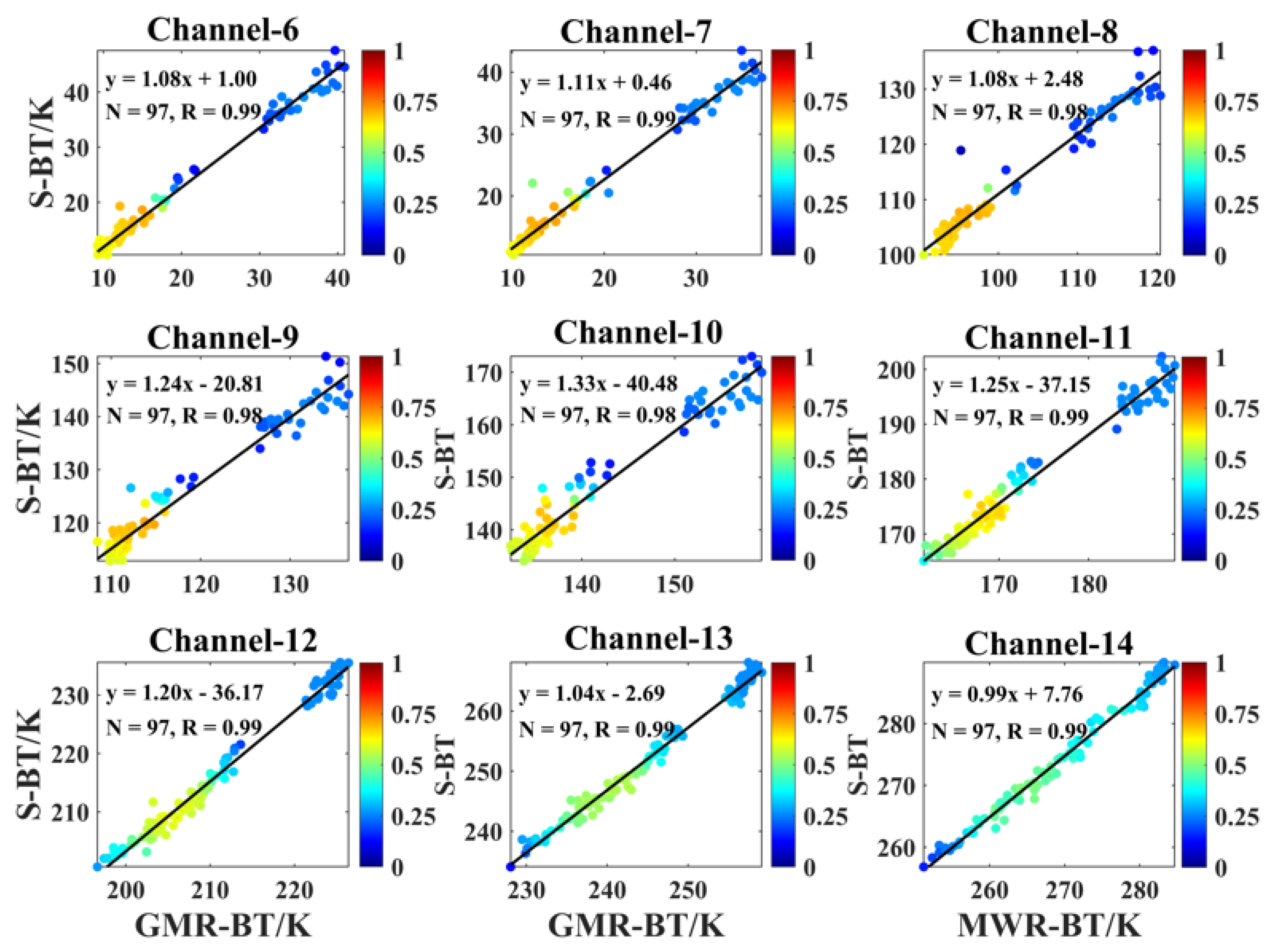


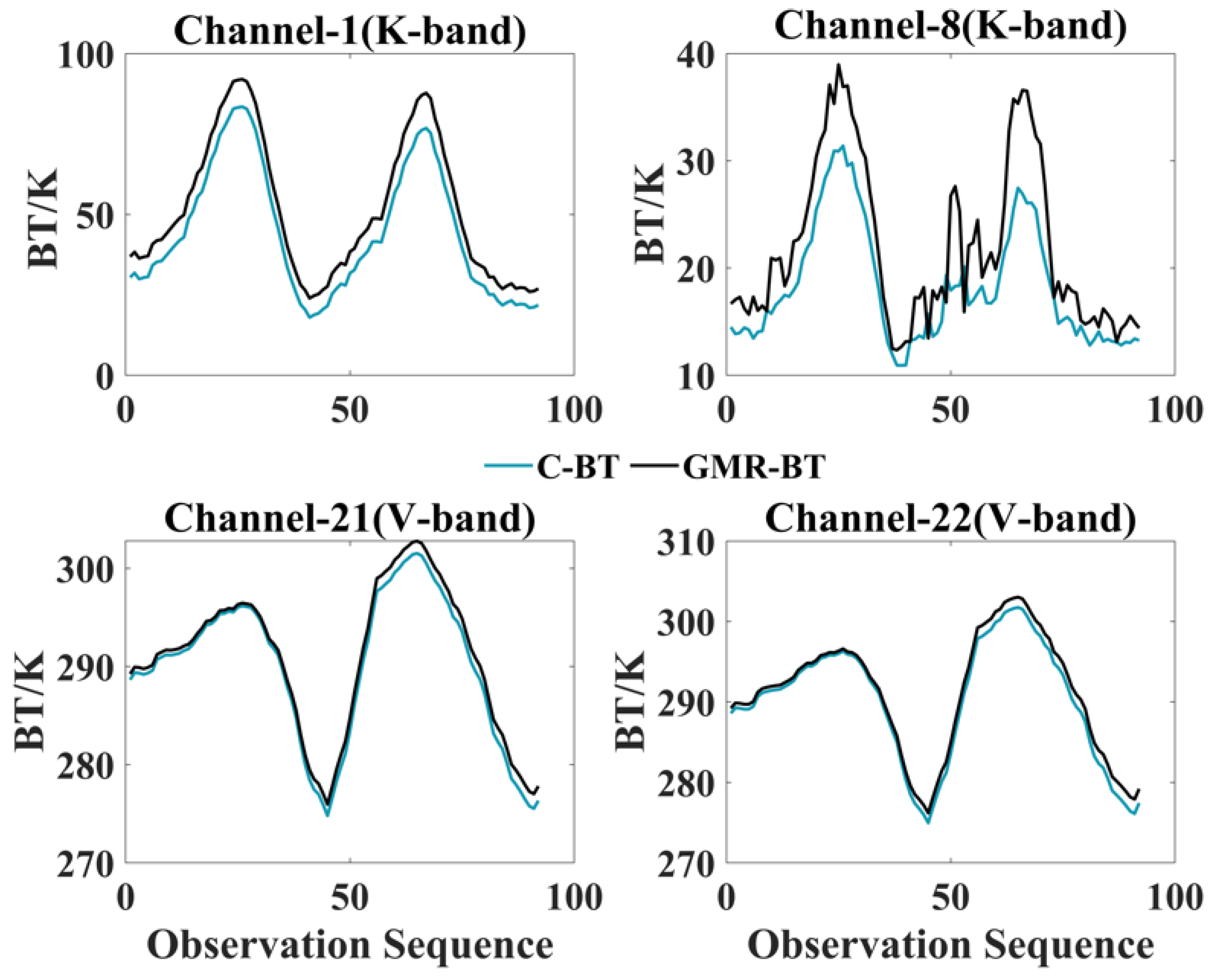

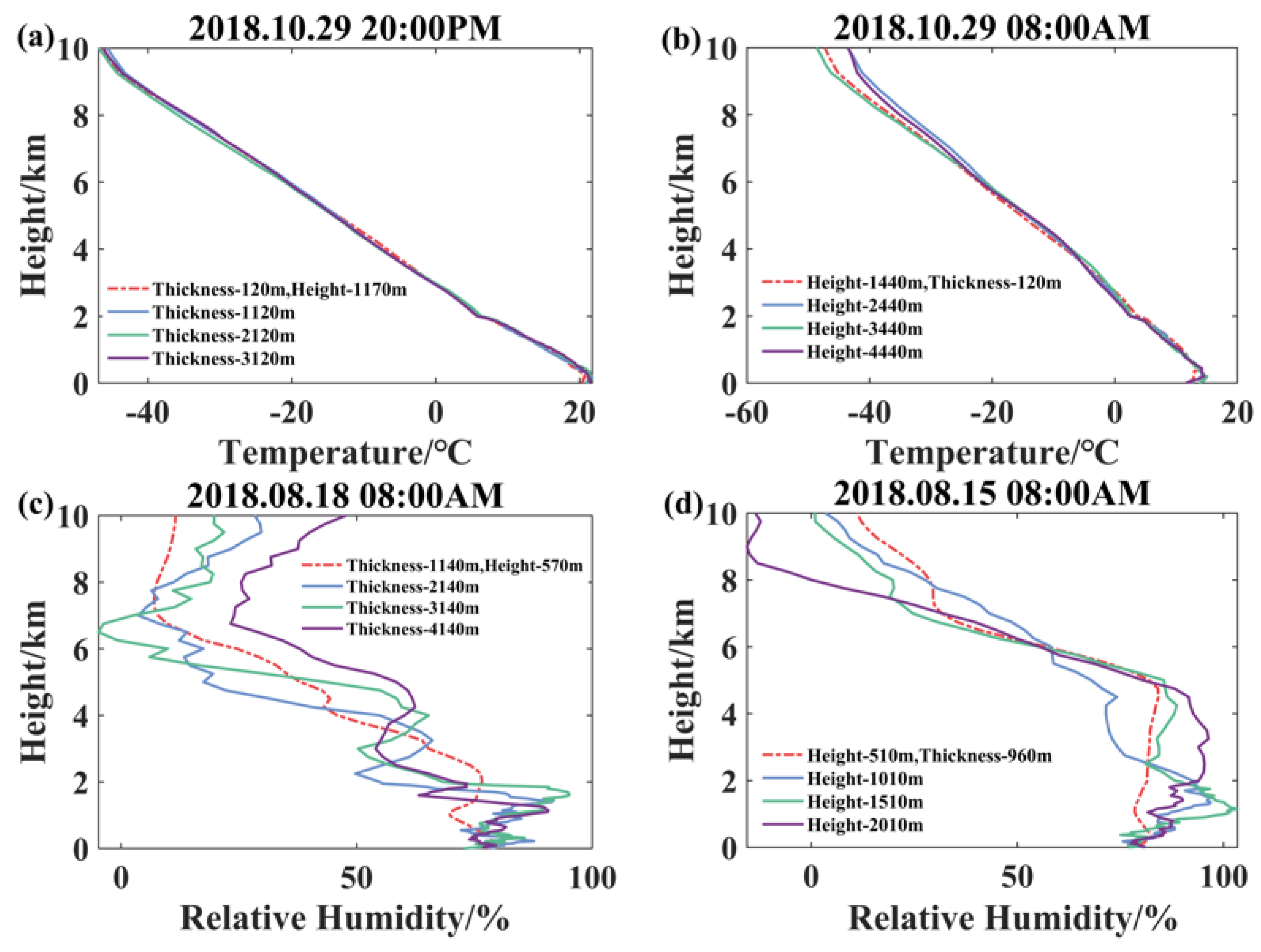
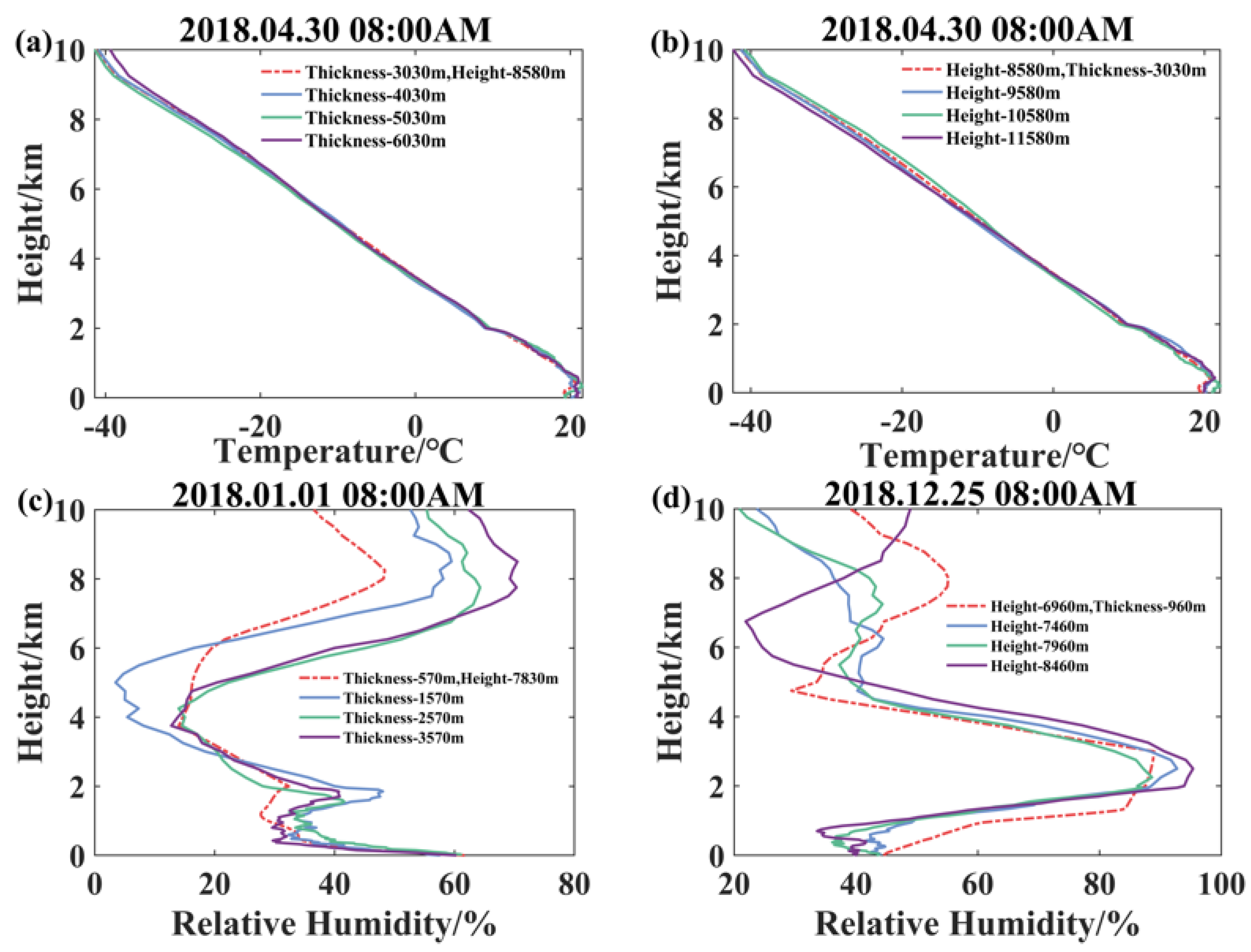


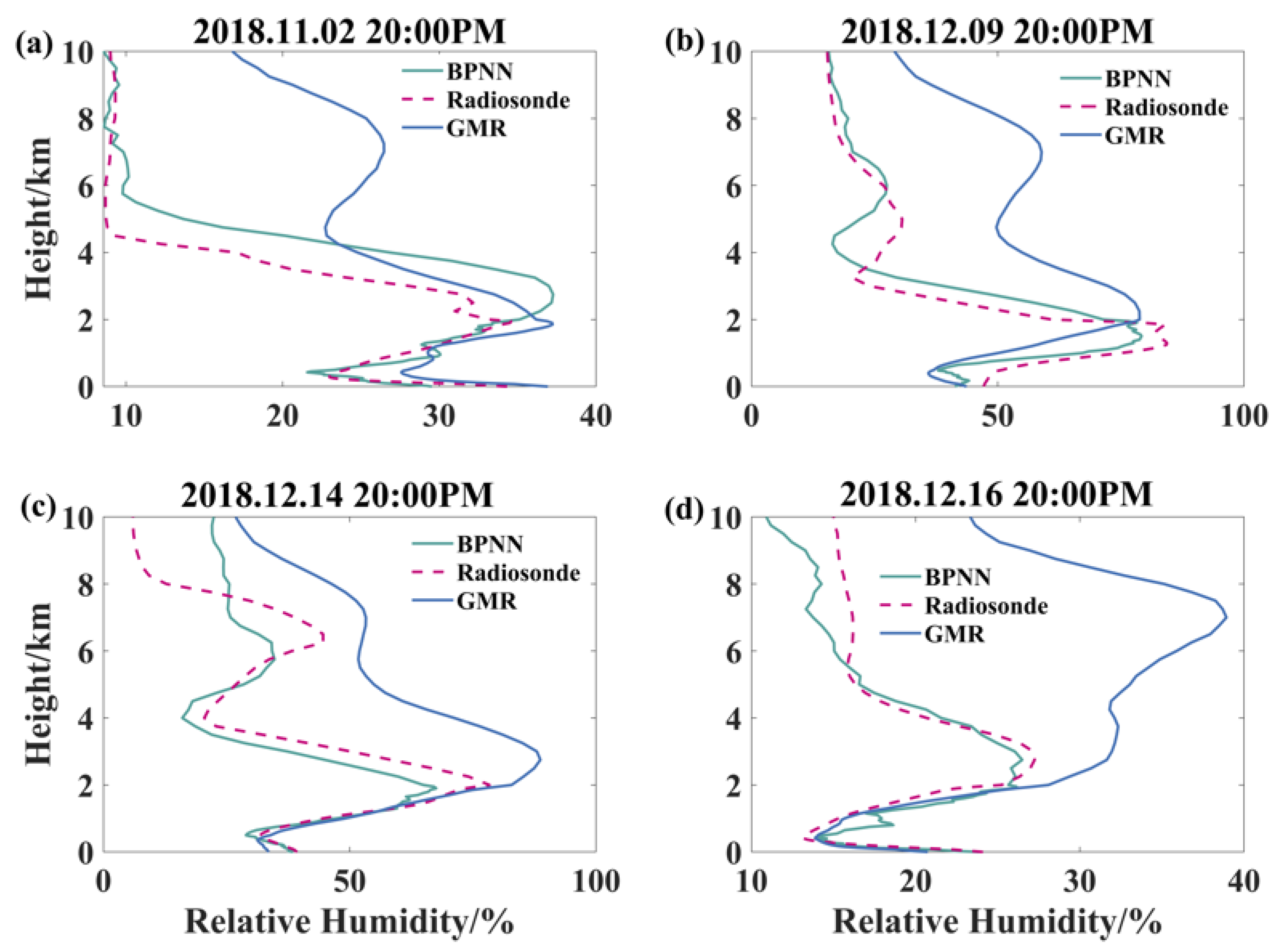
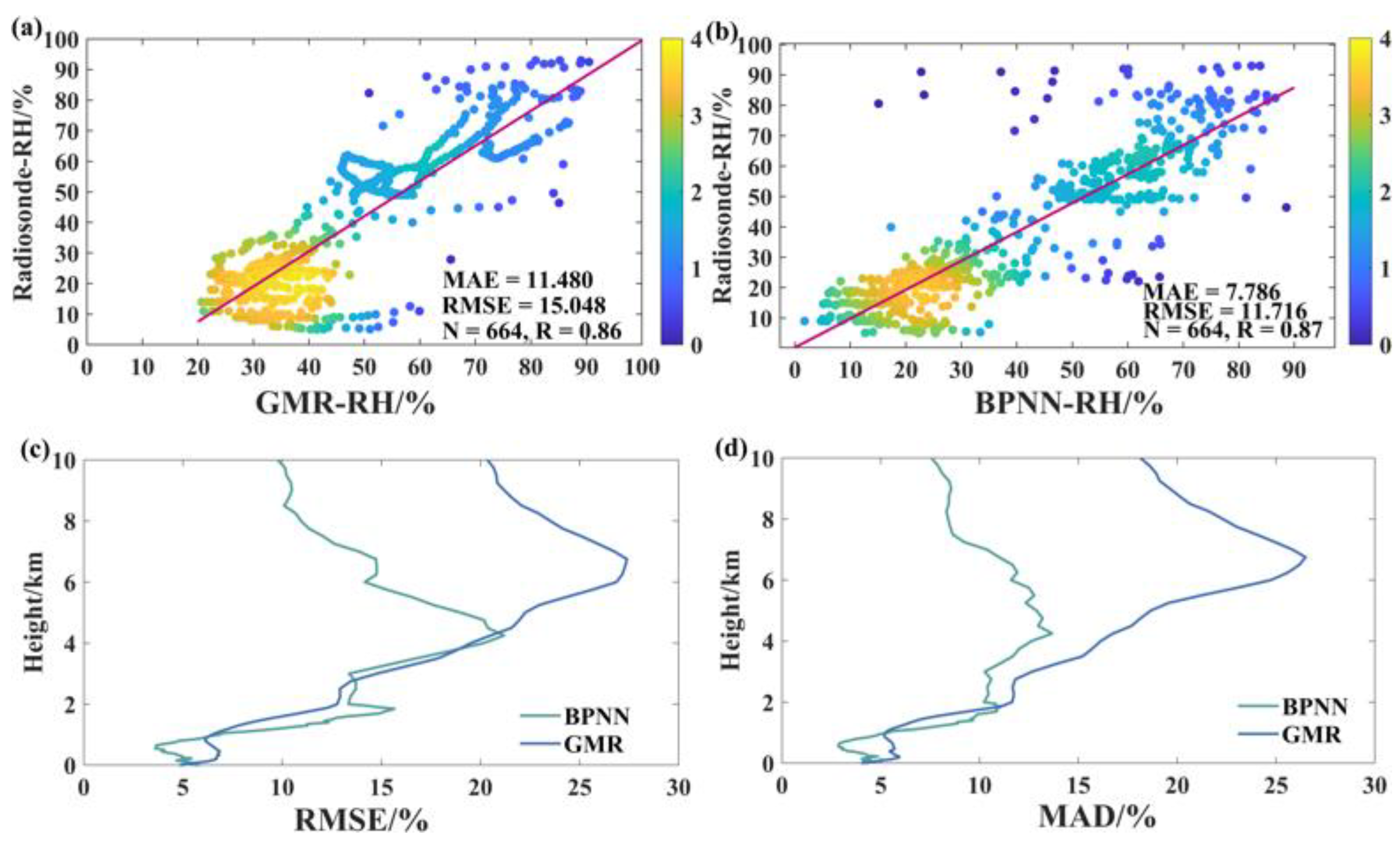
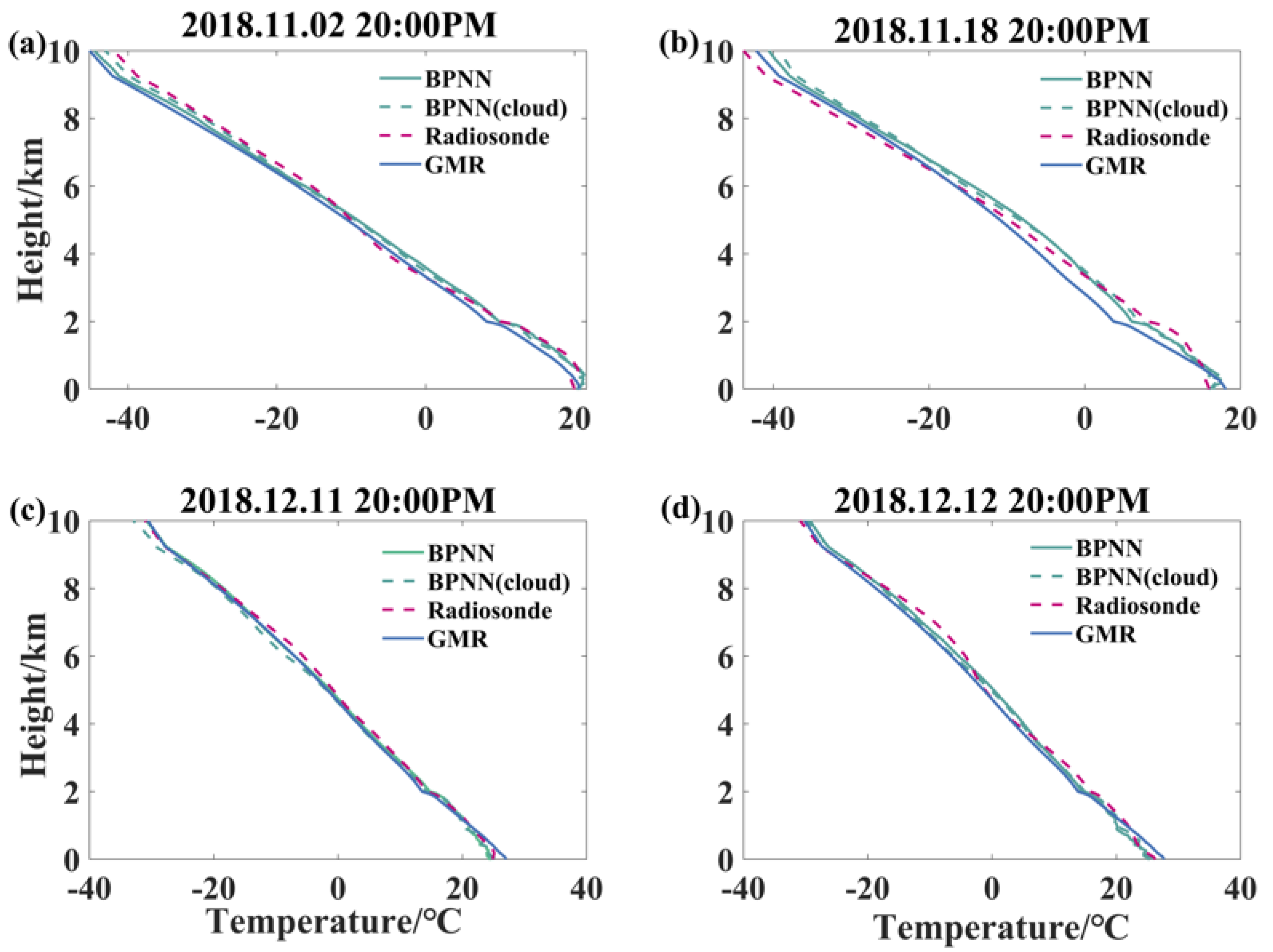

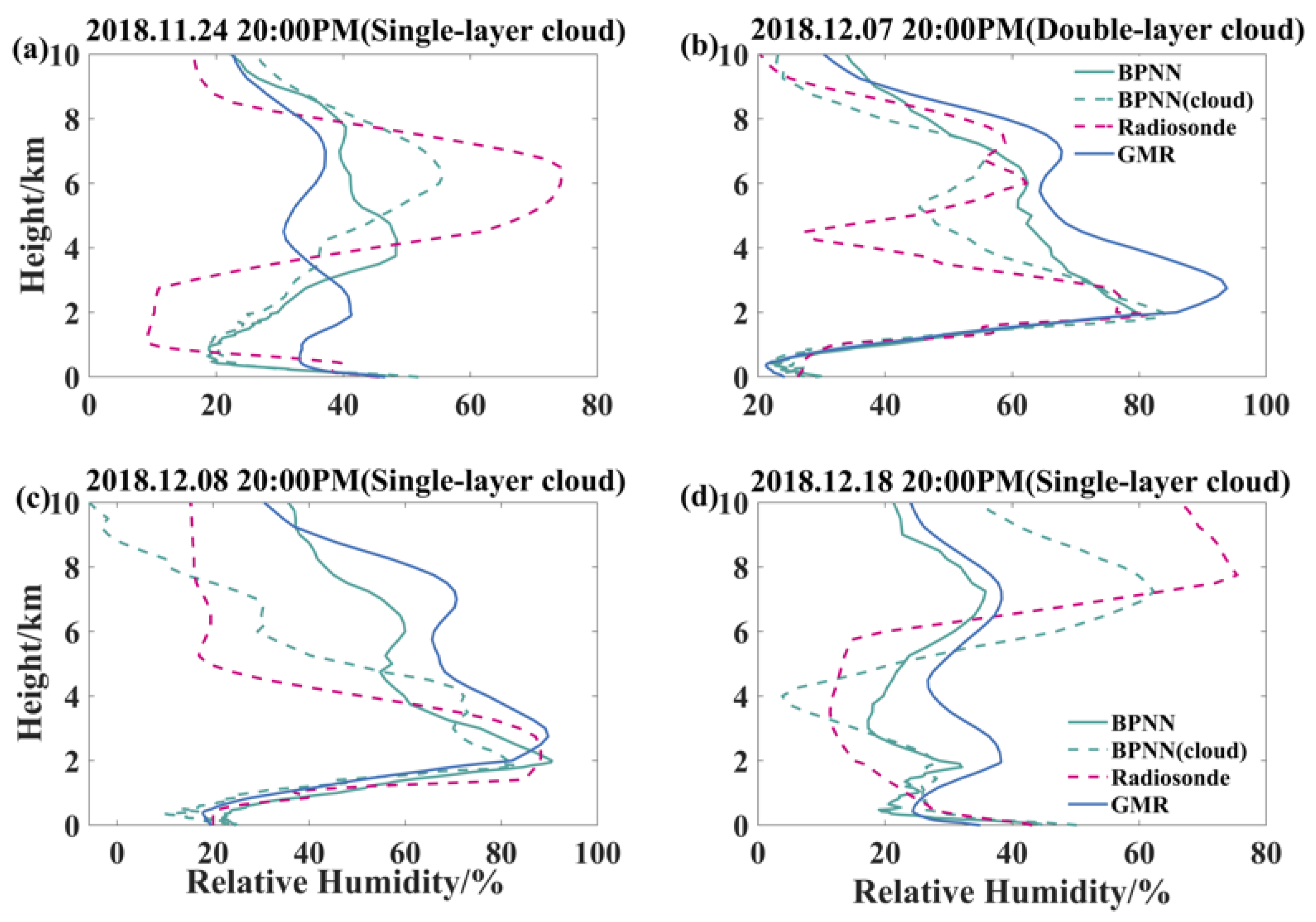
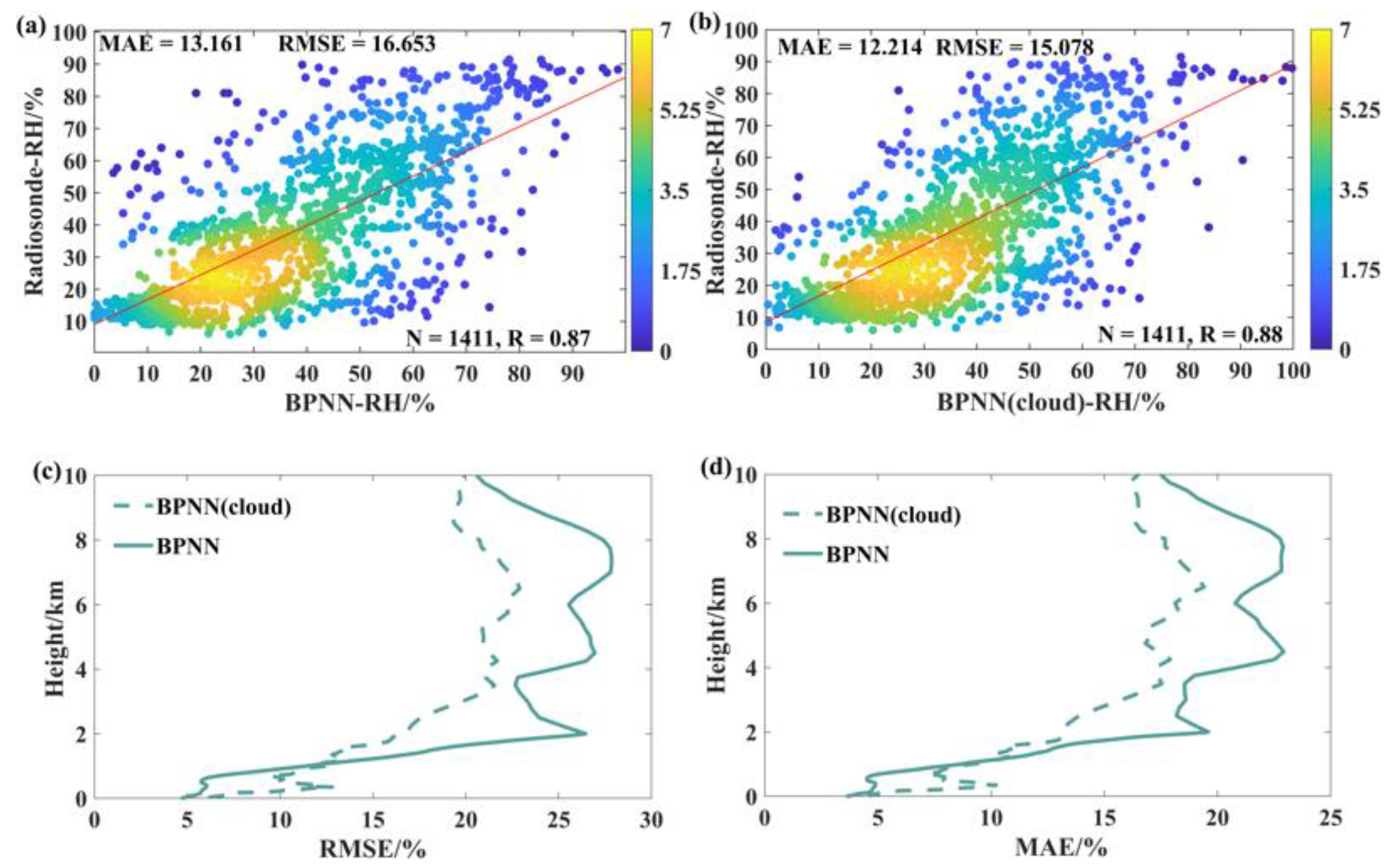
| Parameters | Specifications |
|---|---|
| Resolution of brightness temperature (K) | ≤0.2 |
| Measurement range of brightness temperature (K) | 0–400 |
| Brightness temperature accuracy (K) | 0.5 |
| Brightness temperature sensitivity | K-band: ≤0.25 K; V-band: ≤0.3 K |
| Observation channels on K-band (GHz) | CH1~CH8: 22.235, 22.5, 23.035, 23.835, 25, 26.235, 28, and 30 |
| Observation channels on V-band (GHz) | CH9~CH22: 51.25, 51.76, 52.28, 52.8, 53.34, 53.85, 54.4, 54.94, 55.5, 56.02, 56.66, 57.29, 57.96, and 58.8 |
| Vertical resolution (m) | 25 (surface-500) 50 (500–2000) 250 (2000–10,000) |
| Time resolution (min) | 2 in 2018 |
| Average beamwidth (°) | 3.8 for K-band, and 1.9 for K-band |
| Radiometer calibration Methods | Liquid nitrogen calibration Tipping calibration |
| Parameters | Specifications |
|---|---|
| Working frequency | Ka-band, 35 GHz ± 200 MHz |
| Antenna scanning method | Vertical fixed pointing |
| Beamwidth | ≤0.6° |
| First secondary valve | ≤−20 dB |
| Antenna gain | ≥50 dB |
| Transmit peak power | ≥20 W |
| Ultimate improvement factor | ≥25 dB |
| Receive system linear dynamic range | ≥80 dB |
| System minimum measurable signal power | ≤−110 dBm |
| Detection height range | Detection ≥ 15 km |
| Detection blind area | ≤150 m |
| Distance resolution | 30 m |
| Reflectivity factor (Z) | ≤1 dBZ |
| Radial velocity (V) | ≤0.5 m/s |
| Velocity spectrum width (W) | ≤0.5 m/s |
| Cloud-top height | cloud height < 1000 m, ±100 m; cloud height ≥ 1000 m, ±10% |
| Cloud-base height | cloud height < 1000 m, ±100 m; cloud height ≥ 1000 m, ±10% |
| Channel Frequency/GHZ | Coefficient K | Coefficient B |
|---|---|---|
| 22.235 | 0.96 | −3.82 |
| 22.500 | 0.99 | −4.95 |
| 23.035 | 0.96 | −2.95 |
| 23.835 | 0.96 | −3.14 |
| 25.000 | 0.90 | −1.91 |
| 26.235 | 0.90 | −0.58 |
| 28.000 | 0.90 | −0.56 |
| 30.000 | 0.90 | −0.43 |
| 51.250 | 0.80 | 0.37 |
| 51.760 | 0.80 | 16.91 |
| 52.280 | 0.70 | 33.18 |
| 52.800 | 0.79 | 31.18 |
| 53.340 | 0.85 | −28.23 |
| 53.850 | 0.90 | −1.33 |
| 54.400 | 1.00 | −18.53 |
| 54.940 | 1.08 | −23.77 |
| 55.500 | 1.00 | −9.68 |
| 56.020 | 1.00 | −8.48 |
| 56.660 | 1.00 | −25.83 |
| 57.290 | 1.05 | −16.29 |
| 57.960 | 1.09 | −26.05 |
| 58.800 | 1.08 | −22.49 |
| Retrieval Algorithm | Advantage | Disadvantage |
|---|---|---|
| Neural network | Very high precision; Fast computing speed; No modeling required; Algorithmic stability. | Relies on historical data |
| Kalman filter | Fast computing speed; Error estimation | Relies on historical data; Relies on precision filtering model; Filter divergence. |
| Genetic algorithm | Monitoring of anomalous changes | Long computation time |
| Iterative algorithm | Simple to use | Instability |
Disclaimer/Publisher’s Note: The statements, opinions and data contained in all publications are solely those of the individual author(s) and contributor(s) and not of MDPI and/or the editor(s). MDPI and/or the editor(s) disclaim responsibility for any injury to people or property resulting from any ideas, methods, instructions or products referred to in the content. |
© 2024 by the authors. Licensee MDPI, Basel, Switzerland. This article is an open access article distributed under the terms and conditions of the Creative Commons Attribution (CC BY) license (https://creativecommons.org/licenses/by/4.0/).
Share and Cite
Zhang, L.; Ma, Y.; Lei, L.; Wang, Y.; Jin, S.; Gong, W. Improving Atmospheric Temperature and Relative Humidity Profiles Retrieval Based on Ground-Based Multichannel Microwave Radiometer and Millimeter-Wave Cloud Radar. Atmosphere 2024, 15, 1064. https://doi.org/10.3390/atmos15091064
Zhang L, Ma Y, Lei L, Wang Y, Jin S, Gong W. Improving Atmospheric Temperature and Relative Humidity Profiles Retrieval Based on Ground-Based Multichannel Microwave Radiometer and Millimeter-Wave Cloud Radar. Atmosphere. 2024; 15(9):1064. https://doi.org/10.3390/atmos15091064
Chicago/Turabian StyleZhang, Longwei, Yingying Ma, Lianfa Lei, Yujie Wang, Shikuan Jin, and Wei Gong. 2024. "Improving Atmospheric Temperature and Relative Humidity Profiles Retrieval Based on Ground-Based Multichannel Microwave Radiometer and Millimeter-Wave Cloud Radar" Atmosphere 15, no. 9: 1064. https://doi.org/10.3390/atmos15091064







